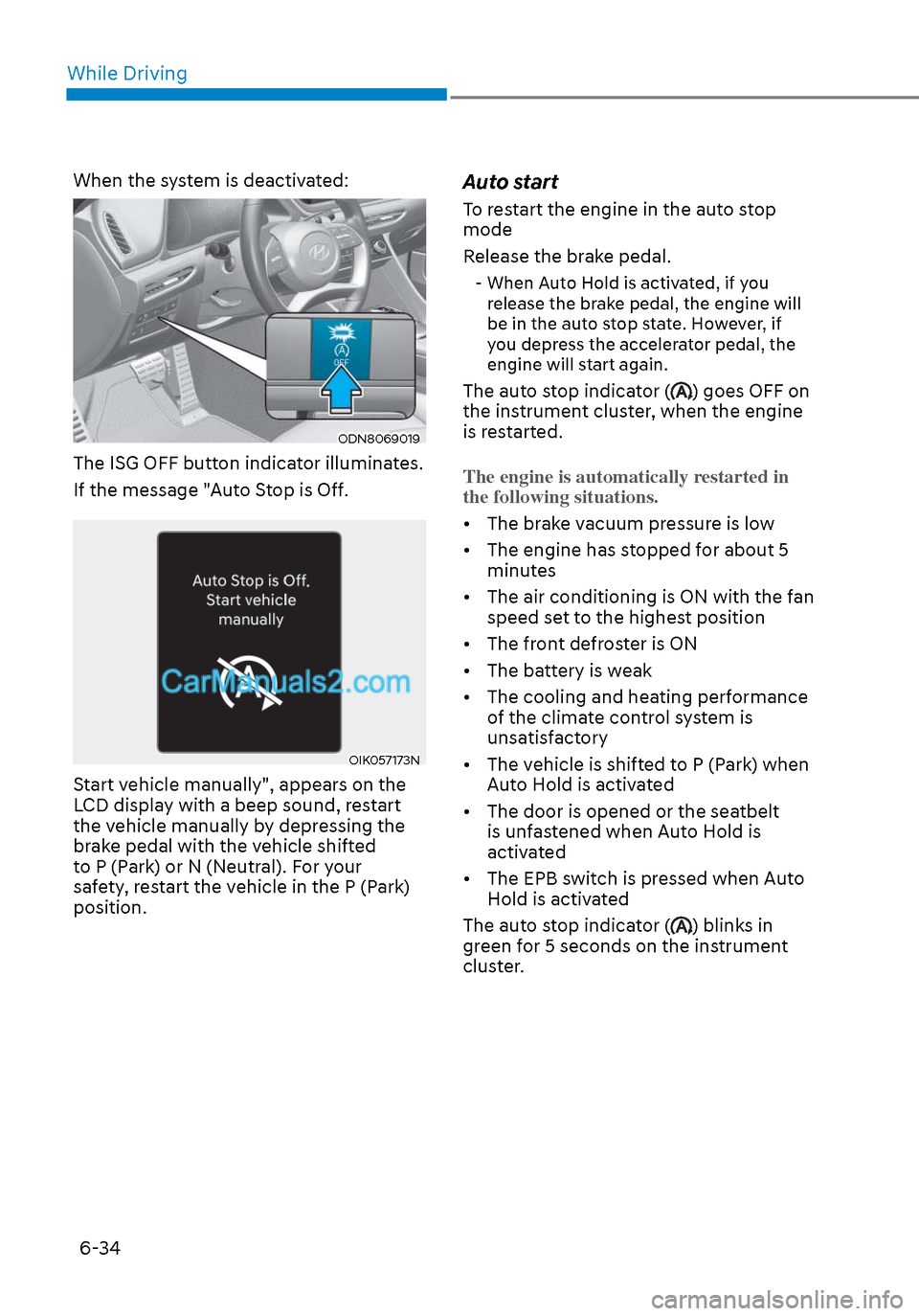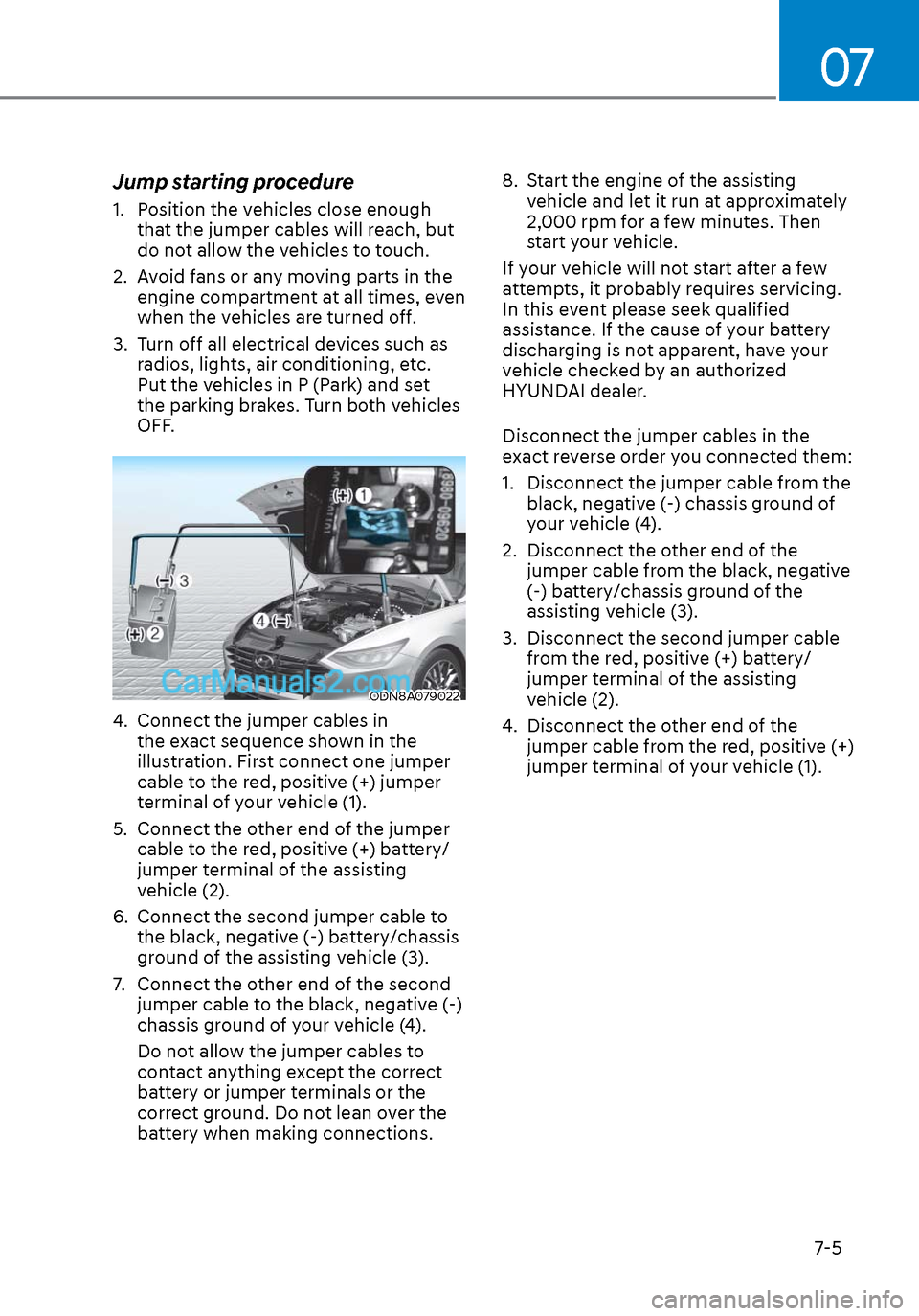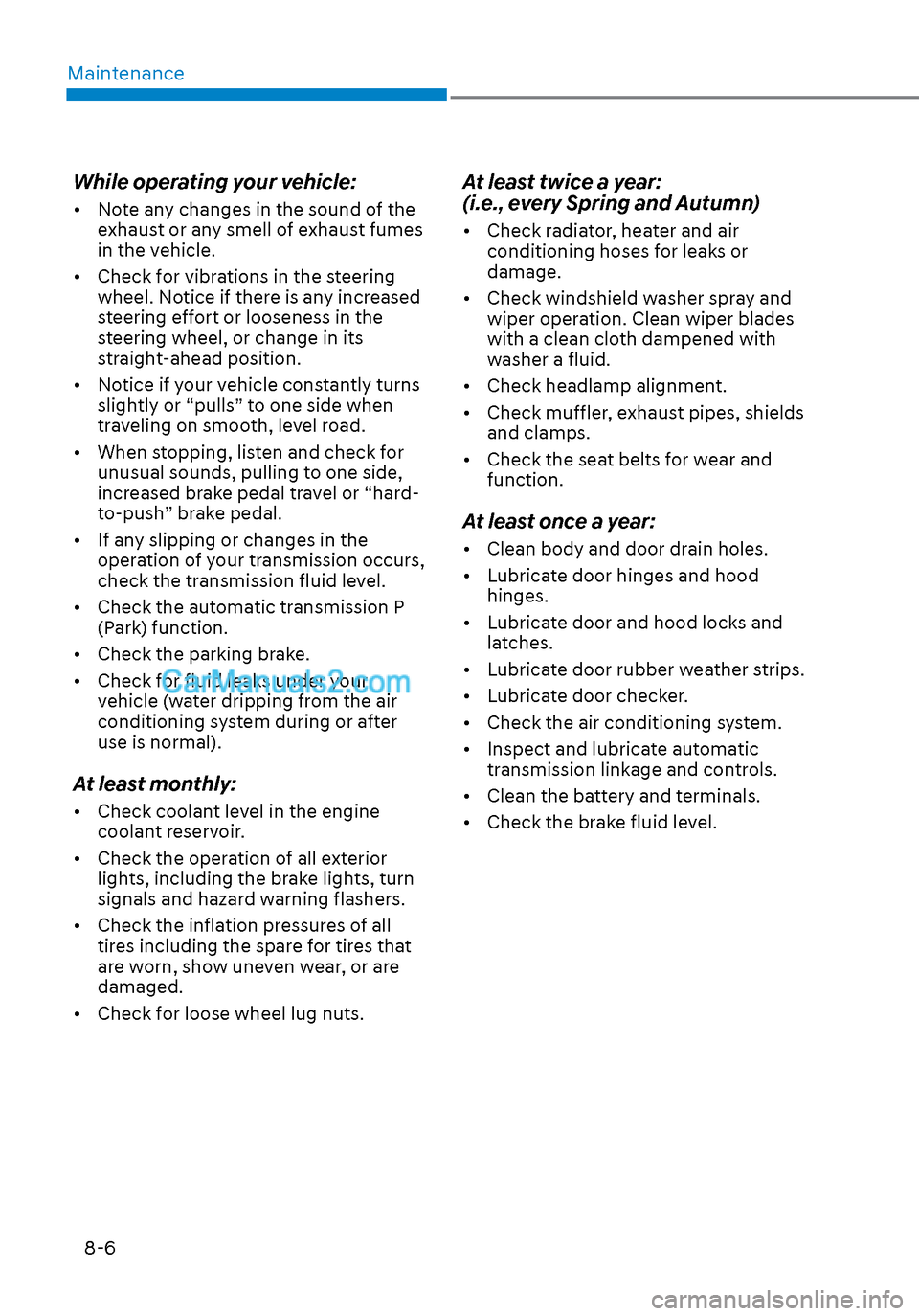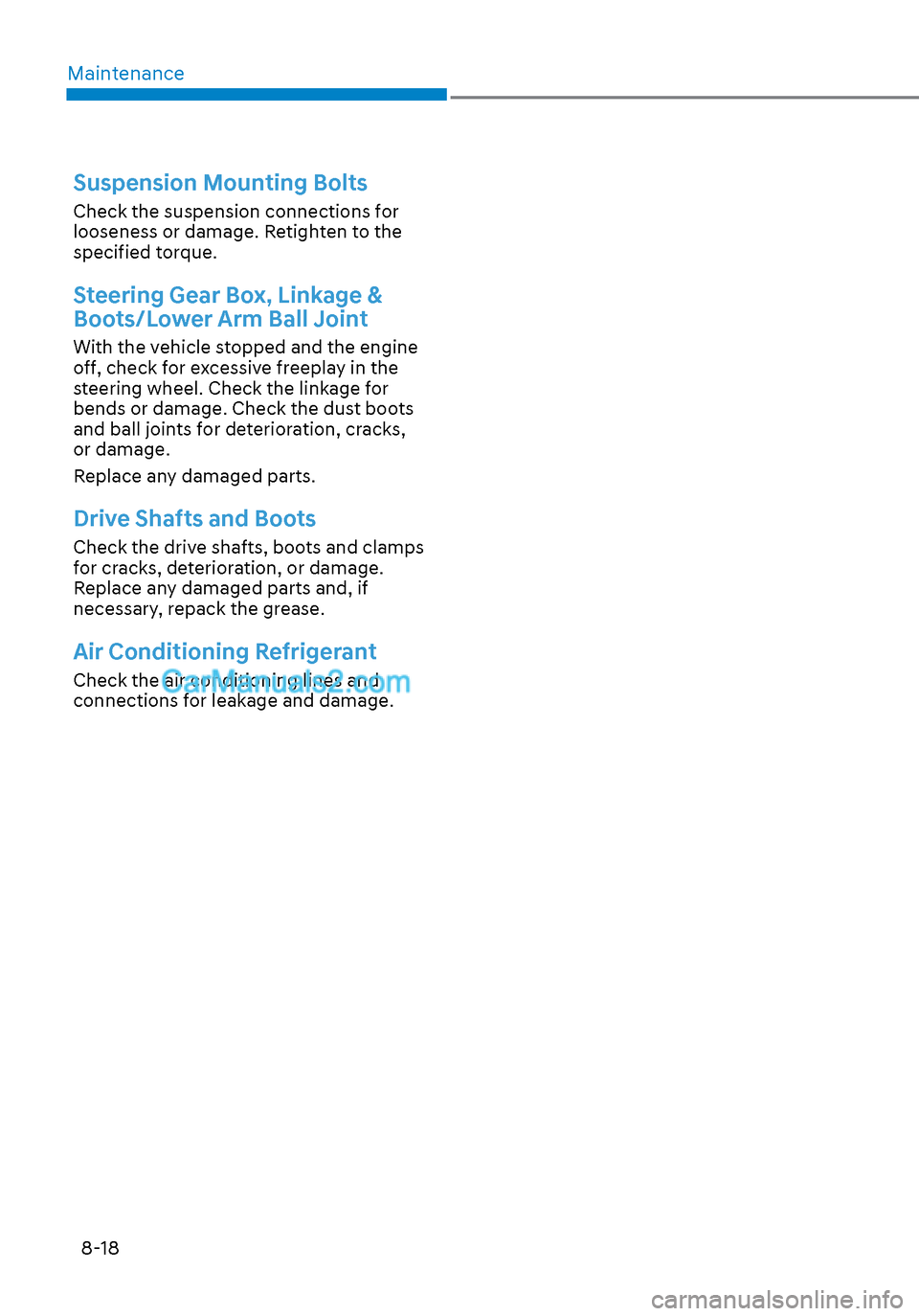2020 Hyundai Sonata air conditioning
[x] Cancel search: air conditioningPage 318 of 537

While Driving6-34
When the system is deactivated:
ODN8069019ODN8069019
The ISG OFF button indicator illuminates.
If the message "Auto Stop is Off.
OIK057173NOIK057173N
Start vehicle manually", appears on the
LCD display with a beep sound, restart
the vehicle manually by depressing the
brake pedal with the vehicle shifted
to P (Park) or N (Neutral). For your
safety, restart the vehicle in the P (Park)
position.
Auto start
To restart the engine in the auto stop
mode
Release the brake pedal.
- When Auto Hold is activated, if you release the brake pedal, the engine will
be in the auto stop state. However, if
you depress the accelerator pedal, the
engine will start again.
The auto stop indicator () goes OFF on
the instrument cluster, when the engine
is restarted.
The engine is automatically restarted in
the following situations.
• The brake vacuum pressure is low
•
The engine has stopped for about 5
minutes
• The air conditioning is ON with the fan speed set to the highest position
• The front defroster is ON
• The battery is weak
• The cooling and heating performance of the climate control system is
unsatisfactory
• The vehicle is shifted to P (Park) when Auto Hold is activated
• The door is opened or the seatbelt is unfastened when Auto Hold is
activated
• The EPB switch is pressed when Auto Hold is activated
The auto stop indicator (
) blinks in
green for 5 seconds on the instrument
cluster.
Page 433 of 537

07
7-5
Jump starting procedure
1. Position the vehicles close enough that the jumper cables will reach, but
do not allow the vehicles to touch.
2. Avoid fans or any moving parts in the engine compartment at all times, even
when the vehicles are turned off.
3. Turn off all electrical devices such as radios, lights, air conditioning, etc.
Put the vehicles in P (Park) and set
the parking brakes. Turn both vehicles
OFF.
ODN8A079022ODN8A079022
4. Connect the jumper cables in the exact sequence shown in the
illustration. First connect one jumper
cable to the red, positive (+) jumper
terminal of your vehicle (1).
5. Connect the other end of the jumper cable to the red, positive (+) battery/
jumper terminal of the assisting
vehicle (2).
6. Connect the second jumper cable to the black, negative (-) battery/chassis
ground of the assisting vehicle (3).
7. Connect the other end of the second jumper cable to the black, negative (-)
chassis ground of your vehicle (4).
Do not allow the jumper cables to
contact anything except the correct
battery or jumper terminals or the
correct ground. Do not lean over the
battery when making connections. 8. Start the engine of the assisting
vehicle and let it run at approximately
2,000 rpm for a few minutes. Then
start your vehicle.
If your vehicle will not start after a few
attempts, it probably requires servicing.
In this event please seek qualified
assistance. If the cause of your battery
discharging is not apparent, have your
vehicle checked by an authorized
HYUNDAI dealer.
Disconnect the jumper cables in the
exact reverse order you connected them:
1. Disconnect the jumper cable from the black, negative (-) chassis ground of
your vehicle (4).
2. Disconnect the other end of the jumper cable from the black, negative
(-) battery/chassis ground of the
assisting vehicle (3).
3. Disconnect the second jumper cable from the red, positive (+) battery/
jumper terminal of the assisting
vehicle (2).
4. Disconnect the other end of the jumper cable from the red, positive (+)
jumper terminal of your vehicle (1).
Page 434 of 537

Emergency Situations7-6
If your temperature gauge indicates
overheating, you experience a loss of
power, or hear loud pinging or knocking,
the engine may be overheating. If this
happens, you should:
1. Pull off the road and stop as soon as it is safe to do so.
2. Place the shift button in P (Park) and set the parking brake. If the air
conditioning is ON, turn it OFF.
3. If engine coolant is running out under the vehicle or steam is coming out
from the hood, stop the engine. Do
not open the hood until the coolant
has stopped running or the steaming
has stopped. If there is no visible
loss of engine coolant and no steam,
leave the engine running and check
to be sure the engine cooling fan is
operating. If the fan is not running,
turn the engine off.
WARNING
While the engine is running,
keep hands, clothing and tools
away from the moving parts
such as the cooling fan and
drive belt to prevent serious
injury.
4. Check for coolant leaking from the radiator, hoses or under the vehicle. (If
the air conditioning had been in use, it
is normal for cold water to be draining
from it when you stop.)
5. If engine coolant is leaking out, stop the engine immediately and call the
nearest authorized HYUNDAI dealer
for assistance.
WARNING
Your vehicle is equipped
with a pressurized coolant
reserve tank. NEVER remove
the engine coolant reservoir
tank/radiator cap or the drain
plug while the engine and
radiator are HOT. Hot coolant
and steam may blow out under
pressure, causing serious
injury.
Turn the engine off and wait until the
engine cools down. Use extreme care
when removing the engine coolant
reservoir tank/radiator cap. Wrap
a towel or thick rag around it, and
turn it counterclockwise slowly to
release some of the pressure from the
system. Step back while the pressure is
released.
When you are sure all the pressure has
been released, continue turning the cap
counterclockwise to remove it.
6. If you cannot find the cause of the overheating, wait until the engine
temperature has returned to normal.
Then, if coolant has been lost,
carefully add coolant to the reservoir
to bring the fluid level in the reservoir
up to the halfway mark.
7. Proceed with caution, keeping alert for further signs of overheating. If
overheating happens again, call
an authorized HYUNDAI dealer for
assistance.
CAUTION
Serious loss of coolant indicates a
leak in the cooling system and should
be checked as soon as possible by an
authorized HYUNDAI dealer.
IF THE ENGINE OVERHEATS
Page 453 of 537

Maintenance8-6
While operating your vehicle:
• Note any changes in the sound of the exhaust or any smell of exhaust fumes
in the vehicle.
• Check for vibrations in the steering wheel. Notice if there is any increased
steering effort or looseness in the
steering wheel, or change in its
straight-ahead position.
• Notice if your vehicle constantly turns slightly or “pulls” to one side when
traveling on smooth, level road.
• When stopping, listen and check for unusual sounds, pulling to one side,
increased brake pedal travel or “hard-
to-push” brake pedal.
• If any slipping or changes in the operation of your transmission occurs,
check the transmission fluid level.
• Check the automatic transmission P (Park) function.
• Check the parking brake.
• Check for fluid leaks under your vehicle (water dripping from the air
conditioning system during or after
use is normal).
At least monthly:
• Check coolant level in the engine coolant reservoir.
• Check the operation of all exterior lights, including the brake lights, turn
signals and hazard warning flashers.
• Check the inflation pressures of all tires including the spare for tires that
are worn, show uneven wear, or are
damaged.
• Check for loose wheel lug nuts.
At least twice a year:
(i.e., every Spring and Autumn)
• Check radiator, heater and air conditioning hoses for leaks or
damage.
• Check windshield washer spray and wiper operation. Clean wiper blades
with a clean cloth dampened with
washer a fluid.
• Check headlamp alignment.
• Check muffler, exhaust pipes, shields and clamps.
• Check the seat belts for wear and function.
At least once a year:
• Clean body and door drain holes.
• Lubricate door hinges and hood hinges.
• Lubricate door and hood locks and latches.
• Lubricate door rubber weather strips.
• Lubricate door checker.
• Check the air conditioning system.
• Inspect and lubricate automatic transmission linkage and controls.
• Clean the battery and terminals.
• Check the brake fluid level.
Page 465 of 537

Maintenance8-18
Suspension Mounting Bolts
Check the suspension connections for
looseness or damage. Retighten to the
specified torque.
Steering Gear Box, Linkage &
Boots/Lower Arm Ball Joint
With the vehicle stopped and the engine
off, check for excessive freeplay in the
steering wheel. Check the linkage for
bends or damage. Check the dust boots
and ball joints for deterioration, cracks,
or damage.
Replace any damaged parts.
Drive Shafts and Boots
Check the drive shafts, boots and clamps
for cracks, deterioration, or damage.
Replace any damaged parts and, if
necessary, repack the grease.
Air Conditioning Refrigerant
Check the air conditioning lines and
connections for leakage and damage.
Page 489 of 537

Maintenance8-42
Tire Terminology and Definitions
Air Pressure
The amount of air inside the tire pressing
outward on the tire. Air pressure is
expressed in pounds per square inch
(psi) or kilopascal (kPa).
Accessory Weight
This means the combined weight of
optional accessories. Some examples
of optional accessories are automatic
transmission, power seats, and air
conditioning.
Aspect Ratio
The relationship of a tire’s height to its
width.
Belt
A rubber coated layer of cords that is
located between the plies and the tread.
Cords may be made from steel or other
reinforcing materials.
Bead
The tire bead contains steel wires
wrapped by steel cords that hold the tire
onto the rim.
Bias Ply Tire
A pneumatic tire in which the plies are
laid at alternate angles less than 90
degrees to the centerline of the tread.
Cold Tire Pressure
The amount of air pressure in a tire,
measured in pounds per square inch (psi)
or kilopascals (kPa) before a tire has built
up heat from driving.
Curb Weight
This means the weight of a motor vehicle
with standard and optional equipment
including the maximum capacity of fuel,
oil and coolant, but without passengers
and cargo.
DOT Markings
A code molded into the sidewall
of a tire signifying that the tire is in
compliance with the U.S. Department
of Transportation motor vehicle safety
standards. The DOT code includes the
Tire Identification Number (TIN), an
alphanumeric designator which can
also identify the tire manufacturer,
production plant, brand and date of
production.
GVWR
Gross Vehicle Weight Rating
GAWR FRT
Gross Axle Weight Rating for the Front
Axle.
GAWR RR
Gross Axle Weight Rating for the Rear
axle.
Intended Outboard Sidewall
The side of an asymmetrical tire,
that must always face outward when
mounted on a vehicle.
Kilopascal (kPa)
The metric unit for air pressure.
Light truck (LT) tire
A tire designated by its manufacturer as
primarily intended for use on lightweight
trucks or multipurpose passenger
vehicles.
Load ratings
The maximum load that a tire is rated to
carry for a given inflation pressure.
Load Index
An assigned number ranging from 1 to
279 that corresponds to the load carrying
capacity of a tire.
Page 521 of 537

IndexI-2
A
Air bag warning labels ........................................................................\
................. 3-57
Air bags ........................................................................\
........................................ 3-37 Driver’s air bag ........................................................................\
....................... 3-39
Passenger’s front air bag ........................................................................\
......... 3-39
Side air bags ........................................................................\
............................ 3-40
Curtain air bags ........................................................................\
....................... 3-41
How does the air bags system operate?...................................\
........................ 3-42
SRS components and functions ....................................................................... 3-42
SRS warning light ........................................................................\
................... 3-43
What to expect after an air bag inflates ........................................................... 3-46
Occupant Classification System (OCS) .......................................................... 3-47
Why didn’t my air bag go off in a collision .................................................... 3-52
Air bag collision sensors ........................................................................\
......... 3-53
Air bag inflation conditions ........................................................................\
.... 3-54
Air bag non-inflation conditions ..................................................................... 3-54
SRS Care ........................................................................\
................................. 3-56
Additional safety precautions ........................................................................\
.. 3-57
Air bag warning labels ........................................................................\
............ 3-57
Air cleaner ........................................................................\
................................... 8-26
Air cleaner filter replacement ........................................................................\
...... 8-26
Air conditioning system specification ................................................................. 2-10
Antenna ................................................................\
.............................................. 5-152
Anti-lock Brake System (ABS) ........................................................................\
... 6-27
Appearance care........................................................................\
........................... 8-61 Exterior care ........................................................................\
............................ 8-61
Interior care ........................................................................\
............................. 8-65
Armrest ................................................................\
................................................ 3-11
Audio / Video / Navigation system .................................................................... 5-154
Auto defogging system ........................................................................\
.............. 5-141
AUTO headlamp position ........................................................................\
............ 5-74
Auto LOCK - Enable on shift ........................................................................\
...... 5-34
Auto LOCK - Enable on speed ........................................................................\
.... 5-34
Auto UNLOCK - Enable on shift ........................................................................\
5-34
Auto UNLOCK -Air bag deployment ................................................................. 5-34
Automatic climate control system ..................................................................... 5-127
Automatic heating and air conditioning ........................................................ 5-128
Manual temperature control mode ................................................................ 5-129
Page 522 of 537

I
I-3
Mode selection ........................................................................\
...................... 5-130
Instrument panel vents ........................................................................\
.......... 5-132
Temperature control ........................................................................\
.............. 5-132
Air intake control ........................................................................\
.................. 5-133
Fan speed control ........................................................................\
.................. 5-134
Air conditioning ........................................................................\
.................... 5-134
OFF mode........................................................................\
.............................. 5-134
System operation ........................................................................\
................... 5-135
System maintenance ........................................................................\
.............. 5-136
Air conditioning refrigerant label......................................\
............................ 5-137
Automatic transmission ........................................................................\
............... 6-13 Transmission ranges ........................................................................\
................ 6-14
Paddle shifter (manual shift mode) ................................................................. 6-19
Shift-lock system ........................................................................\
..................... 6-15
Good driving practices ........................................................................\
............ 6-18
Parking ................................................................\
............................................ 6-16
Automatic ventilation ........................................................................\
................ 5-143
AUX, USB and iPod
® port ........................................................................\
........ 5-152
B
Battery ................................................................\
................................................. 8-31 Battery recharging ........................................................................\
................... 8-32
Battery saver function ........................................................................\
.................. 5-79
Before driving ........................................................................\
................................ 6-5
Blind-Spot Collision Warning (BCW) ................................................................. 6-67
Blind-Spot Collision-Avoidance Assist (BCA) ................................................... 6-67
Blind-Spot View Monitor (BVM) ....................................................................... 6-87
Blue Link
® center ........................................................................\
....................... 5-154
Bluetooth® Wireless Technology hands-free ..................................................... 5-154
Brake fluid ........................................................................\
................................... 8-24
Brake system ........................................................................\
................................ 6-20 Power brakes ........................................................................\
........................... 6-20
Disc brakes wear indicator ........................................................................\
...... 6-20
Electronic Parking Brake (EPB) ..................................................................... 6-21
Auto Hold ........................................................................\
................................ 6-24
Anti-lock Brake System (ABS) ....................................................................... 6-27
Electronic Stability Control (ESC)....................................\
.............................. 6-29
Vehicle Stability Management (VSM) ............................................................ 6-31
Good braking practices ........................................................................\
........... 6-32